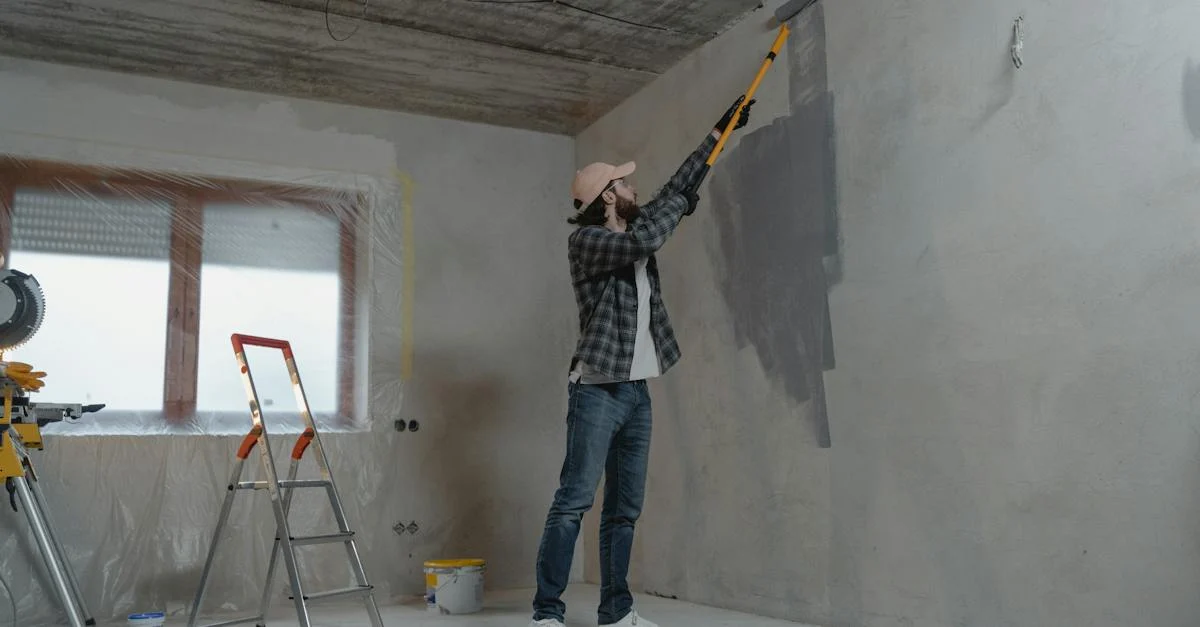Concrete is a durable and versatile material that is used in a wide range of construction projects. From sidewalks and driveways to bridges and buildings, concrete plays a crucial role in our everyday lives. However, over time, concrete can develop cracks, spalling, and other forms of damage due to various factors such as weathering, heavy loads, and poor construction practices.
When concrete starts to deteriorate, it not only affects the aesthetics of the structure but also compromises its structural integrity. That’s where concrete repair comes in. Concrete repair is the process of restoring damaged concrete to its original strength and appearance. It involves identifying the underlying cause of the damage, preparing the surface, and applying suitable repair materials or techniques to fix the problem. Whether it’s a small crack or a large area of deterioration, concrete repair can help extend the lifespan of structures and save on costly replacements.
In this article, we will explore the different types of concrete damage, the common causes, and the various methods and materials used in concrete repair. We will also discuss the importance of timely repairs and the benefits of hiring professionals for concrete repair projects. So, if you’re dealing with cracked or damaged concrete, read on to discover the solutions that can bring your structure back to its former glory.
Types of Concrete Damage
Concrete is a durable material that can withstand various forces and environmental conditions. However, over time, it can develop different types of damage. Understanding these types of concrete damage is crucial for effective repair and maintenance. Here are some common types of concrete damage:
Cracks
Cracks are one of the most common forms of concrete damage. They can occur due to a variety of reasons, including:
- Shrinkage: Concrete undergoes shrinkage as it cures, leading to the formation of cracks.
- Thermal changes: Extreme temperature fluctuations can cause concrete to expand and contract, resulting in cracks.
- Overloading: Excessive loads or weight on the concrete surface can cause it to crack.
- Settling: Uneven settling of the soil beneath the concrete can lead to cracks.
Spalling
Spalling refers to the chipping or flaking of the concrete surface. It can occur due to the following reasons:
- Freeze-thaw cycles: Water can penetrate the concrete, freeze, and expand, resulting in spalling.
- Corrosion: Steel reinforcement within the concrete can rust, causing the surrounding concrete to spall.
- Chemical exposure: Certain chemicals, such as acids or salts, can react with the concrete and cause spalling.
Scaling
Scaling is the loss of the concrete surface in the form of thin flakes or layers. Some common causes of scaling include:
- Poor curing: Improper curing techniques can weaken the concrete surface and lead to scaling.
- Improper concrete mix: If the concrete mix lacks sufficient strength, it can result in scaling.
- Deicing salts: The use of deicing salts can accelerate the scaling process, especially in colder climates.
Efflorescence
Efflorescence is a white crystalline deposit that appears on the surface of concrete. It occurs when water-soluble salts within the concrete migrate to the surface and evaporate, leaving behind the residue.
Discoloration
Concrete may also experience discoloration over time, which can be caused by factors such as:
- Carbonation: Carbon dioxide from the atmosphere reacts with the concrete, resulting in a change in color.
- Chemical stains: Exposure to chemicals or pollutants can cause the concrete to become discolored.
- Algal or fungal growth: Moisture and organic matter can promote the growth of algae or fungi, leading to discoloration.
Common Causes of Concrete Damage
Concrete is a durable material, but it is not invincible. Over time, various factors can cause damage to concrete, compromising its strength and appearance. Understanding the common causes of concrete damage is crucial for effective repair and maintenance. Here are some of the most common culprits:
- Shrinkage and Thermal Changes: Concrete naturally undergoes shrinkage as it cures, leading to the formation of cracks. Additionally, temperature fluctuations can cause the concrete to expand and contract, resulting in further cracking.
- Overloading: Excessive weight or pressure on concrete surfaces can cause them to crack or even collapse. This can occur due to heavy vehicles, equipment, or storage of heavy materials without proper support.
- Freeze-Thaw Cycles: In colder climates, water can penetrate the surface of concrete and freeze during winter. The expanding ice exerts pressure on the concrete, leading to cracking and spalling.
- Corrosion: When reinforcing steel within the concrete comes into contact with moisture and oxygen, it can corrode. This leads to the formation of rust, which can cause the concrete to crack, spall, and weaken over time.
- Poor Curing: Improper curing of concrete during the initial stages of its placement can result in decreased strength and increased susceptibility to damage. Inadequate moisture control or premature removal of forms and supports can compromise the concrete’s integrity.
- Improper Concrete Mix: Incorrect proportions of cement, aggregates, water, or admixtures in the concrete mix can result in a weaker final product. This can make the concrete more prone to cracks, scaling, and other forms of damage.
- Deicing Salts: The use of deicing salts, such as magnesium chloride or sodium chloride, during winter months can accelerate the deterioration of concrete. These salts can penetrate the surface and promote corrosion of the reinforcement, leading to cracking and spalling.
- Carbonation: Over time, carbon dioxide from the atmosphere can react with the alkaline components in the concrete, lowering its pH. This carbonation process can reduce the protective nature of concrete, making it more susceptible to damage.
- Chemical Stains: Exposure to chemicals such as acids, solvents, or petroleum products can cause discoloration and deterioration of the concrete surface.
Importance of Timely Repairs
When it comes to concrete structures, timely repairs are of utmost importance. Ignoring or delaying necessary repairs can lead to further damage, compromising the integrity and safety of the structure. Here are a few reasons why timely repairs are essential:
1. Prevents further deterioration: Concrete damage, if left unattended, can worsen over time. Cracks and gaps, for instance, can allow water to seep in and cause more extensive damage through freeze-thaw cycles. By addressing these issues early on, you can prevent further deterioration and save yourself from costly repairs in the future.
2. Enhances structural integrity: Concrete is relied upon for its strength and durability. However, when it becomes damaged, its ability to withstand external forces is compromised. Timely repairs help restore the structural integrity of concrete, ensuring that it can continue to bear loads and maintain its stability.
3. Minimizes safety risks: Damaged concrete poses safety risks to anyone using or occupying the structure. Cracks and uneven surfaces can lead to trips and falls, while weakened structures may be at higher risk of collapse. Timely repairs address these hazards and promote a safe environment for both residents and visitors.
4. Preserves the aesthetics: Concrete damage can not only affect the functionality of structures but also their appearance. Cracks, stains, and deteriorated surfaces can significantly detract from the visual appeal of a building or infrastructure. By repairing concrete in a timely manner, you can preserve its aesthetics and ensure a pleasing and professional appearance.
5. Saves on costs: Delaying repairs may seem like a cost-saving strategy in the short term, but it can actually lead to higher expenses in the long run. As concrete damage worsens, the required repairs become more extensive and expensive. Additionally, if left unaddressed, concrete damage can potentially lead to structural failure, resulting in even costlier consequences. By promptly fixing concrete issues, you can save on repair costs and avoid significant financial burdens.
Timely repairs are crucial for maintaining the strength, safety, and appearance of concrete structures. By addressing concrete damage as soon as it arises, you can prevent further deterioration, enhance structural integrity, minimize safety risks, preserve aesthetics, and save on costs. Don’t neglect the importance of timely repairs when it comes to maintaining the longevity and functionality of concrete structures.
Methods and Materials Used in Concrete Repair
There are various methods and materials used in concrete repair to address different types of damage. It’s important to choose the right method and materials based on the extent and nature of the damage. Here are some commonly used methods and materials for concrete repair:
- Crack Repair: Cracks in concrete structures are a common issue that needs to be addressed promptly. There are several methods used to repair cracks, such as:
- Epoxy Injection: This method involves injecting epoxy into the cracks to restore the structural integrity of the concrete.
- Polyurethane Injection: Polyurethane is another material used for crack repair, especially for narrow cracks. It provides excellent adhesion and flexibility, allowing the concrete to expand and contract without further damage.
- Routing and Sealing: This method involves cutting a groove along the crack and filling it with a sealant to prevent further cracking and water penetration.
- Spall Repair: Spalling refers to the chipping or flaking of the concrete surface due to corrosion or other factors. To repair spalled concrete, the following methods are commonly used:
- Patching: Small spalled areas can be repaired by applying a patching material that matches the color and texture of the existing concrete.
- Overlay: For larger areas of spalling, an overlay can be applied to restore the surface and provide additional durability.
- Concrete Strengthening: In cases where the concrete has lost its strength, there are methods available to reinforce and strengthen the structure:
- Fiber Reinforcement: Fibers, such as carbon or glass fibers, can be added to the concrete mix to enhance its tensile strength and prevent further cracking.
- Shotcrete: Shotcrete is a method where concrete is sprayed onto the damaged surface, providing immediate reinforcement and restoration of structural integrity.
- Protective Coatings: Applying protective coatings is an essential step in concrete repair to prevent future damage and extend the lifespan of the structure. Commonly used protective coatings include:
- Epoxy Coatings: Epoxy coatings provide a strong and durable surface that resists chemicals, abrasion, and moisture.
- Polyurethane Coatings: Polyurethane coatings offer excellent flexibility and resistance to UV rays, making them suitable for outdoor applications.
Benefits of Hiring Professionals for Concrete Repair Projects
Benefits of Hiring Professionals for Concrete Repair Projects
When it comes to concrete repair projects, hiring professionals is always a smart choice. While some may attempt to tackle these projects themselves, there are several benefits to leaving it in the hands of experts.
- Expertise and Experience
Concrete repair professionals have the necessary expertise and experience to handle a wide range of repair projects. They have a deep understanding of concrete materials, techniques, and best practices. This knowledge allows them to accurately assess the extent of the damage and recommend the most suitable repair method. - Quality Workmanship
One of the key advantages of hiring professionals is the assurance of quality workmanship. These experts have honed their skills over years of experience, ensuring that the repair work is carried out to the highest standards. They have the right tools, equipment, and techniques to ensure a durable and long-lasting repair. - Time and Cost Savings
Taking on a concrete repair project yourself can be time-consuming and costly. Professionals, on the other hand, can complete the repair work efficiently and effectively. They have access to the necessary resources and can work quickly and efficiently to minimize downtime. Choosing professionals for your concrete repair needs can ultimately save you time and money in the long run. - Safety Standards
Concrete repair involves working with heavy materials and equipment, which can pose safety risks to inexperienced individuals. Hiring professionals ensures that the repair work is done safely and in compliance with industry standards. These experts are trained in safety protocols, minimizing the risk of accidents or injuries during the repair process. - Long-Term Benefits
By hiring professionals for your concrete repair projects, you can enjoy the long-term benefits of a job well done. Their expertise and attention to detail ensure that the repairs are done correctly, helping to extend the lifespan of your concrete structure. Additionally, professionals can provide valuable advice on maintenance strategies to prevent future damage.
Hiring professionals for concrete repair projects offers several advantages. Their expertise, quality workmanship, time and cost savings, adherence to safety standards, and long-term benefits make them the ideal choice for any concrete repair needs. So next time you have a concrete repair project, leave it to the professionals and enjoy the peace of mind that comes with a job well done.
Conclusion
Hiring professionals for concrete repair projects offers numerous benefits. Their expertise and experience allow them to accurately assess the extent of the damage and recommend the most suitable repair method. By entrusting the job to professionals, you can ensure quality workmanship, saving both time and money in the long run. Moreover, professionals adhere to safety standards, minimizing the risk of accidents or further damage. Their attention to detail and use of high-quality materials ensure long-term benefits, with repaired concrete structures that are durable and reliable. When it comes to concrete repair, it’s best to leave the job to the professionals for a job well done. So, if you have any concrete repair needs, don’t hesitate to contact experienced professionals who can provide the expertise and quality workmanship required for a successful repair project.



